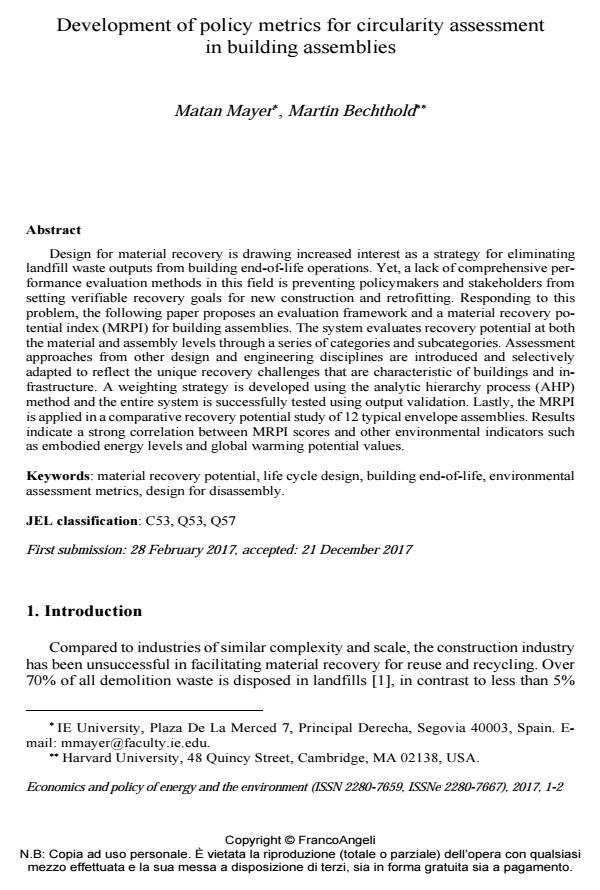Development of policy metrics for circularity assessment in building assemblies
Titolo Rivista ECONOMICS AND POLICY OF ENERGY AND THE ENVIRONMENT
Autori/Curatori Matan Mayer, Martin Bechthold
Anno di pubblicazione 2017 Fascicolo 2017/1-2
Lingua Inglese Numero pagine 28 P. 57-84 Dimensione file 514 KB
DOI 10.3280/EFE2017-001005
Il DOI è il codice a barre della proprietà intellettuale: per saperne di più
clicca qui
Qui sotto puoi vedere in anteprima la prima pagina di questo articolo.
Se questo articolo ti interessa, lo puoi acquistare (e scaricare in formato pdf) seguendo le facili indicazioni per acquistare il download credit. Acquista Download Credits per scaricare questo Articolo in formato PDF

FrancoAngeli è membro della Publishers International Linking Association, Inc (PILA)associazione indipendente e non profit per facilitare (attraverso i servizi tecnologici implementati da CrossRef.org) l’accesso degli studiosi ai contenuti digitali nelle pubblicazioni professionali e scientifiche
Design for material recovery is drawing increased interest as a strategy for eliminating landfill waste outputs from building end-of-life operations. Yet, a lack of comprehensive performance evaluation methods in this field is preventing policymakers and stakeholders from setting verifiable recovery goals for new construction and retrofitting. Responding to this problem, the following paper proposes an evaluation framework and a material recovery potential index (MRPI) for building assemblies. The system evaluates recovery potential at both the material and assembly levels through a series of categories and subcategories. Assessment approaches from other design and engineering disciplines are introduced and selectively adapted to reflect the unique recovery challenges that are characteristic of buildings and infrastructure. A weighting strategy is developed using the analytic hierarchy process (AHP) method and the entire system is successfully tested using output validation. Lastly, the MRPI is applied in a comparative recovery potential study of 12 typical envelope assemblies. Results indicate a strong correlation between MRPI scores and other environmental indicators such as embodied energy levels and global warming potential values.
Parole chiave:Material recovery potential, life cycle design, building end-of-life, environmental assessment metrics, design for disassembly.
Jel codes:C53, Q53, Q57
- Measuring Circularity of Buildings: A Systematic Literature Review Joana dos Santos Gonçalves, Steven Claes, Michiel Ritzen, in Buildings /2025 pp.548
DOI: 10.3390/buildings15040548 - Adapting residential envelope assemblies for full circularity Matan Mayer, in Journal of Physics: Conference Series /2021 pp.012170
DOI: 10.1088/1742-6596/2042/1/012170 - Design for Disassembly (DfD) in construction industry: a literature mapping and analysis of the existing designs Katarzyna Ostapska, Klodian Gradeci, Petra Ruther, in Journal of Physics: Conference Series /2021 pp.012176
DOI: 10.1088/1742-6596/2042/1/012176 - Inconsistencies revealed: A critical analysis of circular economy assessment methods for buildings Saba Mani, M.Reza Hosseini, Gayani Karunsena, Tuba Kocaturk, in Resources, Conservation and Recycling 108203/2025 pp.108203
DOI: 10.1016/j.resconrec.2025.108203 - Circular Construction Process: Method for Developing a Selective, Low CO2eq Disassembly and Demolition Plan Roberta Melella, Giacomo Di Ruocco, Alfonso Sorvillo, in Sustainability /2021 pp.8815
DOI: 10.3390/su13168815 - Sustainable Engineering Matan Mayer, pp.197 (ISBN:978-3-031-47214-5)
- Low Carbon-oriented Design Luca Vanderhaeghe, José R. Albiol-Ibáñez, Jiabin Li, Jasper Vitse, José L. Bonet, Jing Wang, Fei Xue, Yehao Song, Ivan Chin Shing Fu, Sunnie Sing Yeung Lau, Jin Zhang, Yijia Miao, Stephen Siu Yu Lau, pp.1 (ISBN:978-981-96-6738-3)
Matan Mayer, Martin Bechthold, Development of policy metrics for circularity assessment in building assemblies in "ECONOMICS AND POLICY OF ENERGY AND THE ENVIRONMENT" 1-2/2017, pp 57-84, DOI: 10.3280/EFE2017-001005